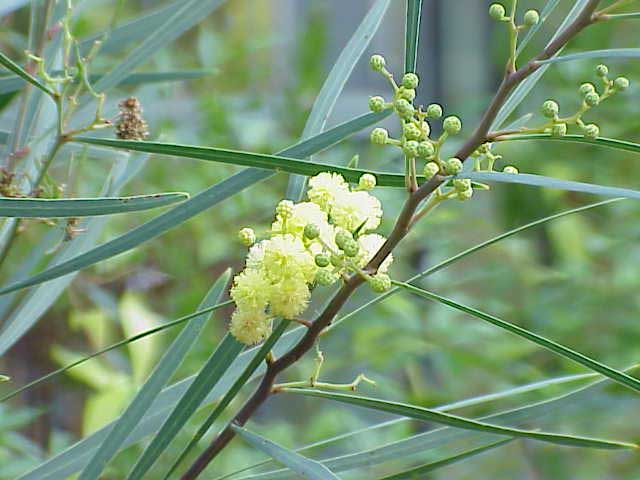
Acacia retinodes (Photo: *)
Classification System: APG IV
Superregnum: Eukaryota
Regnum: Plantae
Cladus: Angiosperms
Cladus: Eudicots
Cladus: Core eudicots
Cladus: Rosids
Cladus: Eurosids I
Ordo: Fabales
Familia: Fabaceae
Subfamilia: Caesalpinioideae
Tribus: Acacieae
Genus: Acacia
Species: Acacia retinodes
Name
Acacia retinodes Schltdl., 1847
Synonyms
Racosperma retinodes (Schltdl.) Pedley
Distribution
Native distribution areas:
Acacia retinodes
Continental: Australasia
Regional: Australia
South Australia
Introduced into:
Argentina Northeast, Assam, Azores, Bolivia, California, Colombia, Costa Rica, Cyprus, Dominican Republic, Easter Is., Ecuador, Ethiopia, France, Great Britain, Hawaii, Honduras, India, Italy, Jawa, Madeira, Morocco, North Caucasus, Peru, Portugal, Romania, Spain, Transcaucasus
References: Brummitt, R.K. 2001. TDWG – World Geographical Scheme for Recording Plant Distributions, 2nd Edition
References
Primary references
Schlechtendal, D.F.L.v., 1847. Linnaea; Ein Journal für die Botanik in ihrem ganzen Umfange. Berlin 20:664. 1847
Links
Govaerts, R. et al. 2020. Acacia retinodes in Kew Science Plants of the World online. The Board of Trustees of the Royal Botanic Gardens, Kew. Published online. Accessed: 2020 Aug 12. Reference page.
International Plant Names Index. 2019. Acacia retinodes. Published online. Accessed: Aug 12 2019.
Tropicos.org 2019. Acacia retinodes. Missouri Botanical Garden. Published online. Accessed: 12 Aug 2019.
Catalogue of Life: 2021 Annual Checklist
Acacia retinodes – Taxon details on World Wide Wattle.
USDA, ARS, Germplasm Resources Information Network. Acacia retinodes in the Germplasm Resources Information Network (GRIN), U.S. Department of Agriculture Agricultural Research Service. Accessed: 09-Oct-10.
Vernacular names
English: Retinodes water wattle, swamp wattle, wirilda, ever-blooming wattle, silver wattle
Acacia retinodes is an evergreen shrub that is native to South Australia, Victoria and Tasmania. Short racemes of yellow flowers are produced periodically throughout the year.[3][4] Some common names are Retinodes water wattle, swamp wattle, wirilda, ever-blooming wattle and silver wattle.[2]
Description
The tree typically grows to a height of 6 to 10 m (20 to 33 ft)[5] and is able to form suckers. It has furrowed bark with a rough texture that is dark brown to black in colour. It has glabrous branchlets that are sometimes pendulous or angular or flattened at extremities. Like most species of Acacia it has phyllodes rather than true leaves. The green to grey-green, glabrous and variable phyllodes are quite crowded on stems and have a narrowly oblanceolate to oblanceolate to linear shape. The phyllodes are 5 to 16 cm (2.0 to 6.3 in) in length and 3 to 16 mm (0.12 to 0.63 in) wide with one main nerve per face. It mostly blooms in summer between December and February.[6]
Acacia retinodes tree
Taxonomy
The species was first formally described by the botanist Diederich Franz Leonhard von Schlechtendal in 1847 as part of the work Sudaustralische Pflanzen. II. Bestimmung und Beschreibung der von Dr Behr in Sudaustralien gesammelten Pflanzen as published in the journal Linnaea: ein Journal für die Botanik in ihrem ganzen Umfange, oder Beiträge zur Pflanzenkunde. It was reclassified as Racosperma retinodes by Leslie Pedley in 2003 then transferred back to genus Acacia in 2007.[7]
Varieties
A. retinodes var. retinodes
A. retinodes var. uncifolia
Distribution
In South Australia it is native to the Mount Lofty Ranges from around Mount Clare to Mount Bryan extending down the Fleurieu Peninsula to around Delamere and Normanville in the south and is regarded as a weed further to the south east. It is commonly situated on low ranges and hills as a part of Eucalyptus woodland communities.[6]
Uses
It is used for environmental management and for ornamental purposes.[2] It produces good quantities of gum and its bark is good for tanning.[4] It has gained the Royal Horticultural Society's Award of Garden Merit.[8][9] In temperate regions it requires a frost-free sheltered spot with full sun.[10] Indigenous Australians ate the gum, after softening it in water, to relieve chest pains.[11]
The plant is grown as a house plant in temperature climates, where it is resistant to most diseases and pests. It can be grown in almost any well-drained potting soil, but requires ample light and water from spring to summer. Watering should be reduced in the fall and winter. Repotting is generally necessary at the start of each growth season. The plant is usually propagated from seed, but can be propagated from cuttings, though these may take several months to root.[12]
See also
List of Acacia species
References
"Acacia retinodes". Australian Plant Name Index (APNI), IBIS database. Centre for Plant Biodiversity Research, Australian Government, Canberra. Retrieved 4 December 2012.
ILDIS LegumeWeb
RHS A-Z encyclopedia of garden plants. United Kingdom: Dorling Kindersley. 2008. p. 1136. ISBN 978-1405332965.
Internet Archive Select Extra-tropical Plants Readily Eligible for Industrial Culture Or Naturalization By Ferdinand von Mueller
Arthur Lee Jacobson Plant of the Month
"Acacia retinodes Schltdl". Wattle - Acacias of Australia. Lucid Central. Retrieved 4 August 2020.
"Acacia retinodes Schltdl". Atlas of Living Australia. Global Biodiversity Information Facility. Retrieved 4 August 2020.
"Acacia retinodes". www.rhs.org. Royal Horticultural Society. Retrieved 27 February 2020.
"AGM Plants - Ornamental" (PDF). www.rhs.org. Royal Horticultural Society. November 2018. p. 1. Retrieved 27 February 2020.
"Acacia retinodes - Wirilda". Adelaide Botanic Garden. Retrieved 23 October 2019.
"Acacia retinodes Wirilda". Plant Selector. Government of South Australia. Retrieved 4 August 2020.
Chiusoli, Alessandro; Boriani, Luisa Maria (1986). Simon & Schuster's guide to houseplants. New York: Simon and Schuster. ISBN 0671631314.
Retrieved from "http://en.wikipedia.org/"
All text is available under the terms of the GNU Free Documentation License

